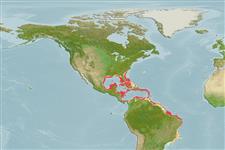Common names from other countries
>
Eupercaria/misc (Various families in series Eupercaria) >
Labridae (Wrasses) > Bodianinae
Etymology: Bodianus: Bodianus after Bodiano or Pudiano, from the Portuguese pudor, meaning modesty (Jordan & Evermann, 1896).; rufus: Name from a Latin adjective meaning 'red' or 'reddish', apparently in reference to the overall reddish yellow coloration of some large individuals of this species. Believed to have been based on Catesby’s (1743) colour figure of this species referred to in Linnaeus’ original description of Labrus rufus, however, the initial-phase adult of B. insularis is also completely red (Ref. 75973).
More on author: Linnaeus.
Environment: milieu / climate zone / depth range / distribution range
Ecologie
marien rifbewoner; diepte 1 - 70 m (Ref. 9710), usually 3 - 70 m (Ref. 27115). Tropical; 22°C - 28°C (Ref. 27115); 33°N - 26°S, 98°W - 34°W
Western Atlantic: Bermuda, southern Florida (USA) and throughout the Gulf of Mexico and Caribbean Sea to southern Brazil.
Grootte / Gewicht / Leeftijd
Maturity: Lm ? range ? - ? cm
Max length : 40.0 cm TL mannelijk / geslacht onbekend; (Ref. 9626); common length : 28.0 cm TL mannelijk / geslacht onbekend; (Ref. 3726); max. gepubliceerd gewicht: 1.0 kg (Ref. 40637)
Dorsale stekels (totaal) : 12; Dorsale zachte stralen (totaal) : 9 - 11; Anale stekels: 3; Anale zachte stralen: 11 - 13. Head, upper front part of body, and front of dorsal fin blue if from shallow water, red if from deep; rest of body and tail yellow. Dorsal, anal, and pelvic fins mostly blue or red-yellow at rear (Ref. 26938).
Adults inhabit rocky or coral reefs (Ref. 9710). Feed on brittle stars, crustaceans, mollusks, and sea urchins (Ref. 9710). Juveniles actively pick parasites from larger fishes (Ref. 5521). A protogynous hermaphrodite (Ref. ). Oviparous, distinct pairing during breeding (Ref. 205). May hybridize with spotfin hogfish, B. pulchellus (Ref. 40096). Marketed fresh (Ref. 3726). Maximum depth reported from Ref. 27115.
Levenscyclus en paargedrag
Maturities | Voortplanting | Spawnings | Egg(s) | Fecundities | Larven
Oviparous (Ref. 205). Forms permanent harem groups composed of a single male and several smaller females (Ref. 55398). Monandric species (Ref. 55398). Sex reversal is completed in 7-10 days (Ref. 34185, 34247). Length at sex change = 17.28 cm TL (Ref. 55398). Spawning occurs at dusk (Ref. 55398).
Robins, C.R. and G.C. Ray, 1986. A field guide to Atlantic coast fishes of North America. Houghton Mifflin Company, Boston, U.S.A. 354 p. (Ref. 7251)
Status op de Rode Lijst van het IUCN (Ref. 130435)
CITES (Ref. 128078)
Not Evaluated
Gevaar voor de mens
Reports of ciguatera poisoning (Ref. 30911)
Gebruik door de mens
Visserij: van minder commercieel belang; Aquarium: Commercieel
Tools
Speciale rapporten
Download XML
Internetbronnen
Estimates based on models
Preferred temperature (Ref.
115969): 23.5 - 28, mean 26.7 (based on 620 cells).
Fylogenetische diversiteitsindex (Ref.
82804): PD
50 = 0.5000 [Uniqueness, from 0.5 = low to 2.0 = high].
Bayesian length-weight: a=0.01202 (0.00693 - 0.02085), b=3.06 (2.90 - 3.22), in cm Total Length, based on LWR estimates for this species & Genus-body shape (Ref.
93245).
Trofisch niveau (Ref.
69278): 3.7 ±0.2 se; based on diet studies.
Weerstandsvermogen (Ref.
120179): Gemiddeld, minimale populatieverdubbelingstijd 1,4-4,4 jaar (Preliminary K or Fecundity.).
Fishing Vulnerability (Ref.
59153): Low to moderate vulnerability (30 of 100).
